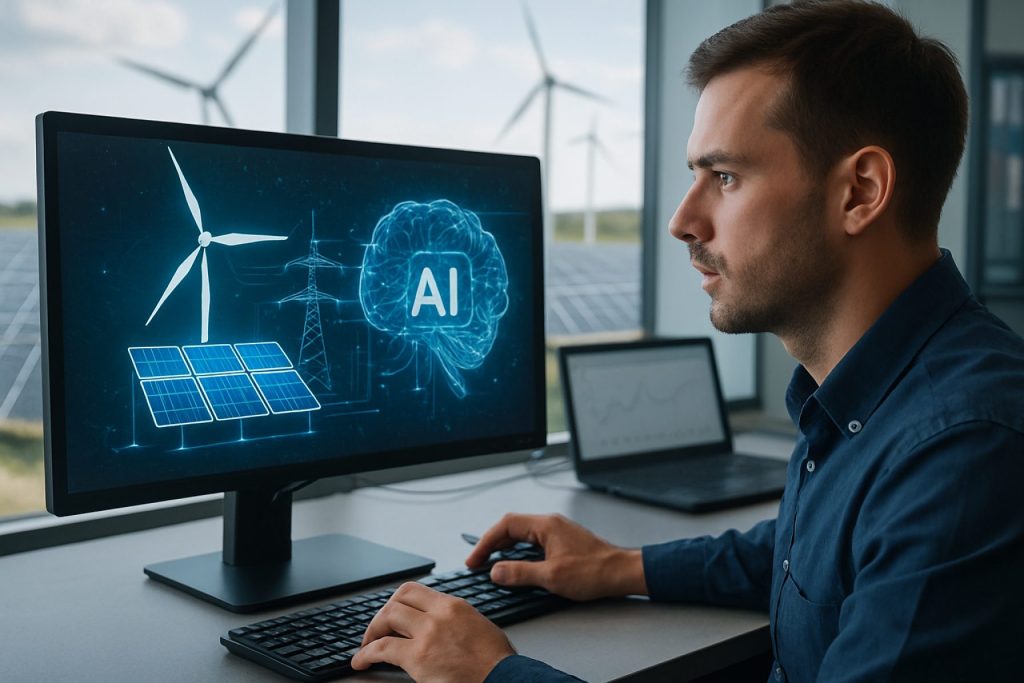
Cyber-Physical Energy Systems Market Report 2025: In-Depth Analysis of AI Integration, Market Growth, and Global Trends. Explore Key Drivers, Forecasts, and Strategic Opportunities Shaping the Industry.
- Executive Summary & Market Overview
- Key Technology Trends in Cyber-Physical Energy Systems
- Competitive Landscape and Leading Players
- Market Growth Forecasts (2025–2030): CAGR, Revenue, and Volume Analysis
- Regional Market Analysis: North America, Europe, Asia-Pacific, and Rest of World
- Future Outlook: Emerging Applications and Investment Hotspots
- Challenges, Risks, and Strategic Opportunities
- Sources & References
Executive Summary & Market Overview
Cyber-Physical Energy Systems (CPES) represent the integration of physical energy infrastructure—such as power grids, distributed energy resources, and storage—with advanced digital technologies, including sensors, communication networks, and intelligent control systems. This convergence enables real-time monitoring, automation, and optimization of energy generation, distribution, and consumption. As the global energy sector accelerates its transition toward decarbonization, decentralization, and digitalization, CPES are emerging as a foundational pillar for modern, resilient, and efficient energy ecosystems.
The CPES market is poised for robust growth in 2025, driven by increasing investments in smart grid modernization, the proliferation of renewable energy sources, and the urgent need for enhanced grid reliability and cybersecurity. According to MarketsandMarkets, the global smart grid market—which forms a significant component of CPES—is projected to reach over $103 billion by 2025, reflecting a compound annual growth rate (CAGR) of approximately 19% from 2020. This expansion is underpinned by government mandates for grid upgrades, rising adoption of distributed energy resources, and the integration of advanced metering infrastructure.
Key industry players—including Siemens, GE, and ABB—are investing heavily in digital platforms and automation solutions that enable seamless interaction between physical assets and cyber systems. These investments are complemented by public sector initiatives, such as the European Union’s Horizon Europe program and the U.S. Department of Energy’s Grid Modernization Initiative, which are channeling significant funding into CPES research, pilot projects, and large-scale deployments (European Commission; U.S. Department of Energy).
The market landscape is also shaped by the growing threat of cyberattacks targeting critical energy infrastructure. As a result, cybersecurity solutions tailored for CPES are experiencing heightened demand, with vendors such as Schneider Electric and Honeywell expanding their offerings to address these vulnerabilities.
In summary, 2025 will see CPES at the forefront of the energy sector’s digital transformation, with market growth propelled by technological innovation, regulatory support, and the imperative for secure, flexible, and sustainable energy systems.
Key Technology Trends in Cyber-Physical Energy Systems
Cyber-Physical Energy Systems (CPES) represent the integration of physical energy infrastructure—such as power grids, distributed energy resources, and storage—with advanced digital technologies, including sensors, communication networks, and intelligent control systems. In 2025, several key technology trends are shaping the evolution and deployment of CPES, driven by the need for greater grid flexibility, resilience, and sustainability.
- Edge Computing and Decentralized Intelligence: The proliferation of distributed energy resources (DERs) and smart devices is accelerating the adoption of edge computing in CPES. By processing data locally at the grid edge, utilities and operators can achieve real-time decision-making, reduce latency, and enhance system reliability. This trend is particularly significant for applications such as microgrid management and demand response, where rapid, localized control is essential (International Energy Agency).
- Advanced Sensing and IoT Integration: The deployment of advanced sensors and Internet of Things (IoT) devices is enabling granular monitoring of grid assets, energy flows, and environmental conditions. These technologies support predictive maintenance, fault detection, and dynamic optimization of energy systems, contributing to improved operational efficiency and reduced downtime (Gartner).
- Artificial Intelligence and Machine Learning: AI and ML algorithms are increasingly being used to forecast energy demand, optimize grid operations, and detect cyber-physical threats. In 2025, these technologies are expected to play a pivotal role in enabling autonomous grid management and enhancing the resilience of CPES against both physical and cyber risks (IEEE).
- Cybersecurity Enhancements: As CPES become more interconnected, the attack surface for cyber threats expands. In response, utilities are investing in advanced cybersecurity solutions, including anomaly detection, blockchain-based authentication, and zero-trust architectures, to safeguard critical infrastructure (National Institute of Standards and Technology).
- Interoperability and Open Standards: The push for interoperability is driving the adoption of open standards and protocols, facilitating seamless integration of diverse devices and systems within CPES. This trend is crucial for enabling vendor-agnostic solutions and supporting the scalability of smart energy ecosystems (Open Geospatial Consortium).
Together, these technology trends are transforming CPES into more adaptive, secure, and intelligent systems, supporting the global transition toward decarbonized and resilient energy infrastructures in 2025 and beyond.
Competitive Landscape and Leading Players
The competitive landscape of the cyber-physical energy systems (CPES) market in 2025 is characterized by rapid technological innovation, strategic partnerships, and a growing emphasis on integrated solutions that bridge operational technology (OT) and information technology (IT). The market is highly fragmented, with a mix of established energy technology giants, specialized cybersecurity firms, and emerging startups focusing on digital transformation in the energy sector.
Leading players in this space include Siemens AG, General Electric, and ABB Ltd., all of which have leveraged their deep expertise in industrial automation and grid management to develop advanced CPES platforms. These companies offer end-to-end solutions that integrate real-time monitoring, predictive analytics, and automated control for power generation, transmission, and distribution networks. Their platforms are increasingly incorporating artificial intelligence and machine learning to optimize energy flows and enhance grid resilience.
Cybersecurity is a critical differentiator in the CPES market. Firms such as Schneider Electric and Honeywell International Inc. have invested heavily in secure-by-design architectures, offering solutions that address both legacy system vulnerabilities and emerging threats from increased connectivity. Meanwhile, cybersecurity specialists like Palo Alto Networks and Fortinet are partnering with energy companies to provide tailored security solutions for critical infrastructure.
The market is also witnessing the rise of innovative startups and niche players, such as AutoGrid Systems and OSIsoft (now part of AVEVA), which focus on advanced data analytics, demand response, and distributed energy resource management. These companies are often at the forefront of integrating renewable energy sources and enabling real-time, decentralized control of energy assets.
Strategic collaborations and mergers are shaping the competitive dynamics. For example, the acquisition of OSIsoft by AVEVA Group has created a powerhouse in industrial data management, while partnerships between utilities and technology providers are accelerating the deployment of CPES solutions globally. According to MarketsandMarkets, the CPES market is expected to see double-digit growth through 2025, driven by the need for grid modernization, increased adoption of renewables, and heightened cybersecurity requirements.
Market Growth Forecasts (2025–2030): CAGR, Revenue, and Volume Analysis
The market for Cyber-Physical Energy Systems (CPES) is poised for robust growth in 2025, driven by the accelerating integration of digital technologies with physical energy infrastructure. According to projections from MarketsandMarkets, the global CPES market is expected to achieve a compound annual growth rate (CAGR) of approximately 8.5% from 2025 through 2030. This growth is underpinned by increasing investments in smart grids, distributed energy resources, and the digitalization of utility operations.
Revenue forecasts for 2025 indicate that the CPES market will surpass $18.2 billion, with North America and Europe leading in adoption due to advanced grid modernization initiatives and supportive regulatory frameworks. The Asia-Pacific region is anticipated to exhibit the fastest growth, propelled by rapid urbanization, expanding renewable energy capacity, and government-led digital transformation programs in countries such as China, Japan, and South Korea (International Data Corporation (IDC)).
Volume analysis reveals a significant uptick in the deployment of CPES components, including intelligent sensors, real-time data analytics platforms, and automated control systems. In 2025, the number of installed smart meters and grid-edge devices is projected to exceed 1.2 billion units globally, reflecting a 12% year-over-year increase (International Energy Agency (IEA)). This surge is attributed to utilities’ efforts to enhance grid reliability, optimize energy consumption, and enable seamless integration of distributed energy resources such as solar PV and battery storage.
- Key growth drivers: The proliferation of Internet of Things (IoT) devices, advancements in artificial intelligence for grid management, and heightened cybersecurity requirements are catalyzing CPES adoption.
- Sectoral momentum: Industrial and commercial sectors are leading CPES investments, particularly in microgrid and demand response solutions.
- Revenue breakdown: Software and analytics platforms are expected to account for over 40% of total market revenue in 2025, as utilities prioritize data-driven decision-making and predictive maintenance.
Overall, 2025 marks a pivotal year for the CPES market, with strong growth trajectories in both revenue and deployment volumes, setting the stage for continued expansion through 2030 as digital and physical energy systems become increasingly intertwined.
Regional Market Analysis: North America, Europe, Asia-Pacific, and Rest of World
The global market for Cyber-Physical Energy Systems (CPES) is experiencing robust growth, with regional dynamics shaped by policy frameworks, technological adoption, and energy transition priorities. In 2025, North America, Europe, Asia-Pacific, and the Rest of the World (RoW) each present distinct opportunities and challenges for CPES deployment.
- North America: The United States and Canada are at the forefront of CPES innovation, driven by significant investments in smart grid modernization and renewable integration. The U.S. Department of Energy’s Grid Modernization Initiative and Canada’s Smart Grid Program are catalyzing the adoption of advanced CPES solutions, particularly in grid resilience and distributed energy resource management. The region’s mature utility sector and strong presence of technology vendors such as GE and Schneider Electric further accelerate market growth. According to MarketsandMarkets, North America is expected to maintain a leading market share in 2025, supported by regulatory mandates and cybersecurity investments.
- Europe: Europe’s CPES market is propelled by ambitious decarbonization targets and the European Union’s Digitalization of Energy Action Plan. Countries like Germany, France, and the UK are investing heavily in smart metering, demand response, and cross-border energy data platforms. The presence of major players such as Siemens and ABB supports a competitive landscape. The European Commission’s focus on interoperability and data privacy is shaping CPES architectures, with the region expected to see double-digit growth rates through 2025, as reported by IDC.
- Asia-Pacific: Rapid urbanization and electrification are fueling CPES adoption in Asia-Pacific, particularly in China, Japan, South Korea, and India. Government-led initiatives such as China’s “New Infrastructure” policy and Japan’s Society 5.0 vision are driving investments in smart grids, microgrids, and IoT-enabled energy management. The region’s market is characterized by large-scale pilot projects and increasing participation from technology giants like Hitachi and Toshiba Energy Systems. According to Fortune Business Insights, Asia-Pacific is projected to be the fastest-growing CPES market segment in 2025.
- Rest of World: In Latin America, the Middle East, and Africa, CPES adoption is emerging, primarily through international development projects and public-private partnerships. Brazil and the UAE are notable for their smart grid pilots and renewable integration efforts. However, market growth is tempered by infrastructure constraints and limited regulatory support. International organizations such as the International Energy Agency (IEA) are playing a key role in knowledge transfer and capacity building.
Overall, regional disparities in policy, infrastructure, and investment will continue to shape the CPES market landscape in 2025, with North America and Europe leading in maturity, Asia-Pacific in growth, and RoW in emerging opportunities.
Future Outlook: Emerging Applications and Investment Hotspots
Looking ahead to 2025, the future of Cyber-Physical Energy Systems (CPES) is shaped by rapid digitalization, the proliferation of distributed energy resources, and the urgent need for grid resilience and decarbonization. CPES, which tightly integrate computational algorithms and physical energy infrastructure, are poised to underpin the next generation of smart grids, microgrids, and energy management platforms.
Emerging applications are expected to focus on real-time grid optimization, predictive maintenance, and autonomous control of distributed assets. The integration of artificial intelligence (AI) and machine learning (ML) into CPES will enable utilities and operators to forecast demand, detect anomalies, and dynamically balance supply with unprecedented accuracy. For example, AI-driven CPES are being piloted to orchestrate virtual power plants, aggregating distributed solar, wind, and storage to provide grid services and participate in energy markets International Energy Agency.
Another key application area is the electrification of transportation. CPES will be central to managing the bi-directional energy flows from electric vehicles (EVs), supporting vehicle-to-grid (V2G) services, and optimizing charging infrastructure. This is particularly relevant as global EV adoption accelerates, with the number of EVs on the road projected to surpass 77 million by 2025 BloombergNEF.
Investment hotspots are emerging in regions with ambitious decarbonization targets and advanced digital infrastructure. North America and Europe are leading in CPES deployments, driven by regulatory support for smart grid modernization and renewable integration. Asia-Pacific, particularly China and Japan, is rapidly scaling investments in CPES to support urbanization and grid reliability MarketsandMarkets.
- Grid-edge intelligence: Startups and established players are investing in edge computing solutions for real-time control and cybersecurity of distributed assets.
- Resilient microgrids: CPES-enabled microgrids are attracting capital for critical infrastructure, especially in disaster-prone or remote areas.
- Transactive energy platforms: Blockchain and CPES convergence is enabling peer-to-peer energy trading and decentralized market models.
As digital twins, IoT, and advanced analytics mature, CPES will become the backbone of a flexible, secure, and sustainable energy ecosystem. Investors are expected to prioritize ventures that demonstrate scalable, interoperable, and cyber-resilient CPES solutions, positioning the sector for robust growth through 2025 and beyond.
Challenges, Risks, and Strategic Opportunities
Cyber-Physical Energy Systems (CPES) represent the convergence of physical energy infrastructure with advanced digital control, communication, and automation technologies. As these systems become increasingly integral to modern energy grids, they face a complex landscape of challenges and risks, but also present significant strategic opportunities for stakeholders in 2025.
Challenges and Risks
- Cybersecurity Threats: The integration of IT and operational technology (OT) in CPES expands the attack surface for cyber threats. High-profile incidents, such as the 2021 Colonial Pipeline attack, underscore the vulnerability of energy infrastructure to ransomware and other cyberattacks. According to the International Energy Agency, the frequency and sophistication of attacks on energy systems are expected to rise, necessitating robust, adaptive security frameworks.
- System Complexity and Interoperability: CPES involve heterogeneous devices, protocols, and legacy systems, making seamless interoperability a persistent challenge. The lack of standardized communication protocols can hinder integration and increase operational risks, as highlighted by the National Institute of Standards and Technology.
- Data Privacy and Integrity: The vast data flows within CPES raise concerns about data privacy, ownership, and integrity. Unauthorized access or manipulation of data can disrupt grid operations or compromise consumer trust, as noted by Gartner.
- Regulatory and Compliance Risks: Evolving regulations around data protection, grid reliability, and cross-border energy flows require continuous adaptation. Non-compliance can result in financial penalties and reputational damage, as outlined by the European Commission.
Strategic Opportunities
- Grid Resilience and Flexibility: Advanced CPES enable real-time monitoring, predictive maintenance, and automated response to disturbances, enhancing grid resilience. The International Energy Agency projects that digitalization could reduce unplanned outages by up to 50% by 2025.
- Integration of Renewables and Distributed Energy Resources (DERs): CPES facilitate the seamless integration of variable renewables and DERs, supporting decarbonization goals and new business models, as emphasized by Enerdata.
- Market Innovation: The data-driven nature of CPES opens avenues for new services, such as demand response, peer-to-peer energy trading, and predictive analytics, creating value for utilities and consumers alike, according to McKinsey & Company.
Sources & References
- MarketsandMarkets
- Siemens
- GE
- European Commission
- Honeywell
- International Energy Agency
- IEEE
- National Institute of Standards and Technology
- Open Geospatial Consortium
- Palo Alto Networks
- Fortinet
- OSIsoft
- AVEVA Group
- International Data Corporation (IDC)
- Siemens
- Hitachi
- Fortune Business Insights
- Enerdata
- McKinsey & Company



